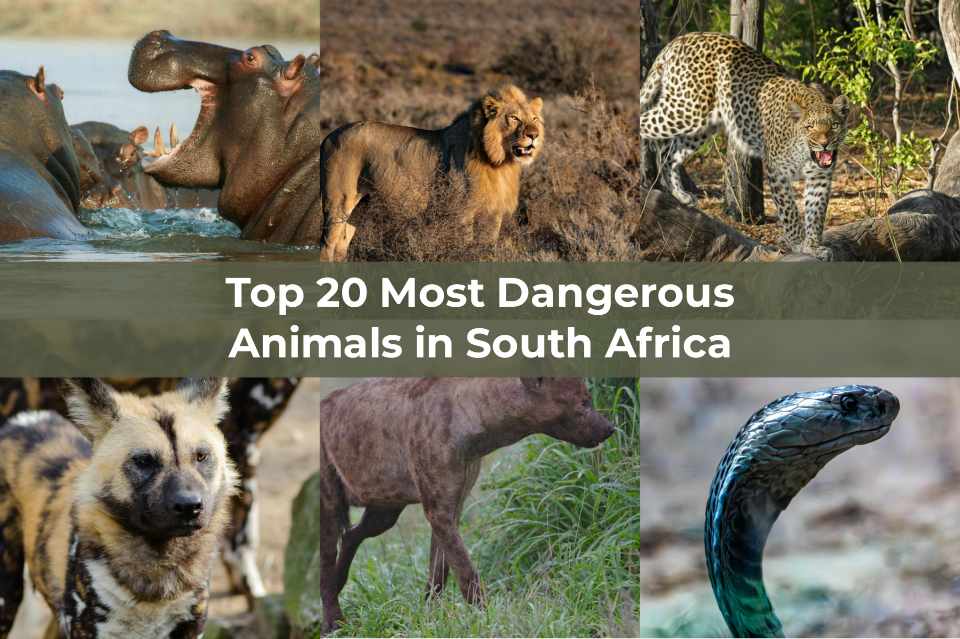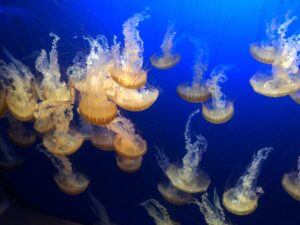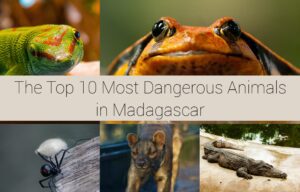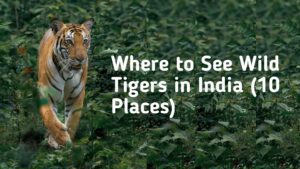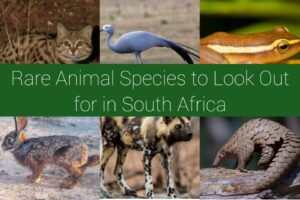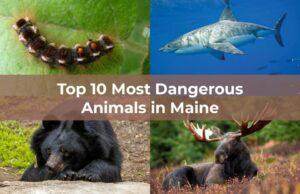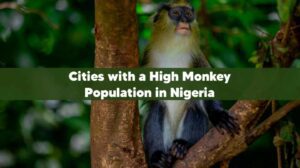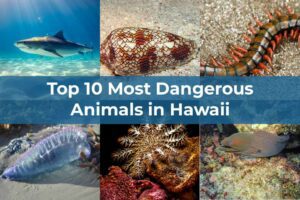South Africa is home to many wild animals, especially the Big Five and other large mammals. Travellers and animal lovers always visit for the diverse wildlife and safari experience.
South Africa is one of the countries with the most wildlife in Africa. There are many national parks, from the iconic Kruger National Park to the rugged coastline of the Western Cape. So you are sure to see most of the popular animals that are native to Africa.
In this article, we will look at the top 20 most dangerous animals in South Africa. You will also learn why they are dangerous and where to see them in South Africa.
Top 20 Most Dangerous Animals in South Africa
1. Hippopotamus

Scientific Name: Hippopotamus amphibius
The Hippopotamus is also known as the common hippopotamus, Nile hippopotamus, river hippopotamus, or hippo for short. They are large semiaquatic animals native to sub-Saharan Africa.
The Hippopotamus is easily one of the most dangerous large animals in Africa. Do not be fooled by their large size; they are surprisingly fast on land and in water.
Hippos are responsible for more than 500 human deaths per year. This is because they are highly territorial and are known to protect their space both in the water and the surrounding banks.
An adult hippo can weigh between 3000 and 4000 pounds, which is approximately 1360 to 1800 kg. Despite their large size, they can run up to 30 km/h (19 mph) on land, which is faster than a human.
Hippopotamuses have one of the strongest bites in the animal kingdom. Their long teeth can grow up to 20 inches long, which is enough to crush bones and flip boats in the water.
Hippos are responsible for more human deaths in Africa than lions, crocodiles, or even elephants. In South Africa, you can spot hippos in Kruger National Park, iSimangaliso Wetland Park, Hluhluwe-iMfolozi Park, Addo Elephant National Park and many other places.
2. Lion

Scientific Name: Panthera leo
The African Lion is the king of the savanna. They are known for their muscular bodies and sharp teeth and claws, which they use to hunt in the wild.
Lions are apex predators that sit at the top of the food chain in Africa. Even with their bulky build, they can run up to 80 km/h or 50 mph in short bursts.
They hunt in groups known as prides. A hungry lion pride can bring down large animals like buffalo, wildebeest, and even giraffes.
Lions rarely attack humans, but incidents can happen if you find yourself in their territory. Their bite force is strong enough to crush the bones of large prey. If you have ever watched a lion feed, you will know that the canines of lions are built for piercing and gripping.
Lions are among the Big Five game animals in Africa. Found throughout most of Southern and East Africa.
In South Africa, the most popular places to see lions are Kruger National Park, Sabi Sands Game Reserve, Kgalagadi Transfrontier Park, Addo Elephant National Park, and Madikwe Game Reserve.

3. Leopard

Scientific Name: Panthera pardus
Another dangerous animal in South Africa is the Leopard. Just like lions, African leopards are among the Big Five game animals in the savanna.
The leopard is the most elusive and arguably one of the most dangerous of the Big Five. Their stealthy and unpredictable behaviour makes them a threat in the wild.
Leopards are masters of camouflage and stealth and prefer to hunt alone at night. They are strong enough to drag prey heavier than themselves up into trees.
A healthy leopard can run up to 58 km/h, which is 36 mph, and they can also leap over 6 metres (20 feet). Their speed and agility make them unpredictable and hard to escape from if they choose to attack.
Just like many other big cats, leopards kill prey by biting the neck or throat with their sharp canines and strong jaws. They also use their retractable claws to grip, slash, and climb trees or rough terrain.
In the wild, leopards are more likely than lions or cheetahs to attack humans. Trust me, you do not want to be face-to-face with these ferocious hunters in their natural habitat.
It is always advisable to have a local guide accompany you on your safari adventure since they know how to stay safe and spot some of these elusive cats.
The top places to see leopards in South Africa are Sabi Sands Game Reserve, Kruger National Park, Londolozi Private Game Reserve, Kgalagadi Transfrontier Park, Madikwe Game Reserve, and Marakele National Park.
4. African Elephant

Scientific Name: Loxodonta africana
The African elephant is the largest land animal in the world. There are two types of African elephants: the African bush elephant and the African forest elephant.
African elephants are intelligent and social creatures that are known to be peaceful in the wild. But they can be dangerous when they feel threatened or are protecting their young.
The enormous size of African elephants makes any attack brutal to other wild predators and humans. Elephants are members of the Big Five game animals in the African savanna.
An adult male African elephant can weigh up to 6000 kg and stand up to 11 feet tall. Even with their strength and size, they can reach speeds of 40 km/h (25 mph) and easily crush vehicles or people.
What many people may not know is that elephants are highly intelligent animals. They have strong memories and have been known to hold grudges.
Elephants are responsible for hundreds of deaths per year in Africa, especially in rural areas where villagers share the same space with these giants.
The top places to see elephants in South Africa are Kruger National Park, Addo Elephant National Park, Tembe Elephant Park, Pilanesberg National Park, Madikwe Game Reserve, and Marakele National Park.
5. African Buffalo

Scientific Name: Syncerus caffer
The African Buffalo is also known as the Cape Buffalo and is considered one of the most dangerous animals in Africa.
African Buffalos are also referred to as “Black Death,” a reputation which they earned from being one of the most dangerous animals to hunt.
An adult buffalo can weigh between 500 and 1,000 kg, and combined with their muscular bodies and heavy, curved horns, they can cause serious injuries or even death if they charge.
Buffalos move in herds large enough to trample lions and other wild predators.
African buffalo are estimated to kill over 200 people per year, making them one of the deadliest animals in Africa. They were given the nicknames “the Black Death” or “the widowmaker” in Africa.
An injured or threatened buffalo can circle back with a group and ambush their attacker. Most of the time, lions receive permanent injuries or even death while trying to hunt a buffalo.
As a member of the big five African game, buffalos are feared and respected in the wild.
6. Rhinoceros

The Rhinoceros is one of the members of the big five game animals. South Africa is home to both White Rhinoceros and Black Rhinoceros.
A rhinoceros, also called a rhino, is one of the fiercest wildlife in the African savanna. They are built like an armoured tank with horns in front.
While white rhinos are generally more calm and less likely to get provoked, black rhinos are known to be more aggressive and unpredictable.
White rhinos can weigh up to 2300 kg, while black rhinos can weigh 1400 kg. Their size makes it easy to crush threats, including vehicles. Rhinos also have poor eyesight; this is why they charge at anything they perceive as a threat.
It is almost impossible to stop a charging rhinoceros running at 50 km/h (31 mph). You can only try to escape or drive the vehicle away from them.
Rhinoceroses are the most critically endangered of the big five due to poaching.
7. African Wild Dog

Scientific Name: Lycaon pictus
The African wild dog is also known as the painted dog or the Cape hunting dog. They are wild canines found only in sub-Saharan Africa.
Although African wild dogs are endangered species, they are still found in South Africa, where they hunt in packs. Attacks on humans are extremely rare because of their endangered status.
In the wild, African wild dogs have a hunting success rate of up to 80%, which is higher than even larger animals like lions and leopards. They use a series of coordinated tactics to hunt prey while chasing it over a long distance.
Imagine multiple dogs tearing an animal apart. This scene is usually chaotic and violent, leaving the animal dead in seconds.
A pack of wild dogs can run up to 66 km/h (41 mph) over long distances. They rely on this speed and endurance to chase prey to exhaustion.
Kruger National Park is one of the best places to see African wild dogs, since there are estimated to be around 200 to 300 wild dogs in the park. Other top places include Sabi Sands Game Reserve, Madikwe Game Reserve, Hluhluwe–iMfolozi Park, and Tswalu Kalahari Reserve.
8. Spotted Hyena

Scientific Name: Crocuta crocuta
You do not want to mess with Spotted Hyenas in the wild. They are powerful predators that are dangerous due to their strong jaws and aggressive nature.
Hyenas are often portrayed as cowardly scavengers, but this is not entirely true since spotted hyenas are highly intelligent and capable of killing large animals.
The bite of a Spotted Hyena is stronger than that of a lion or a bear. Their jaws can crush bones, hooves, and even the tough skin of other animals like elephants.
If you will be camping outdoors, always be prepared for Hyenas and try as much as possible to stay with a local guide.
Spotted Hyenas can be seen in different national parks and reserves in South Africa. In Kruger National Park, Spotted Hyenas are found near Skukuza, Lower Sabie, Satara, and Letaba camps.
9. Black Mamba

Scientific Name: Dendroaspis polylepis
The Black Mamba is one of the most feared snakes in Africa and the world. They are not black in colour but are more of a greyish-brown. Black Mambas got their name from their black mouth, which they open when threatened.
Black Mambas are easily the deadliest snakes in Africa because of their potent venom, speed, and aggressive behaviour.
Aside from being the second longest venomous snake at 9.8 feet, the Black Mamba is also the fastest snake in Africa and one of the fastest in the world. It can move at speeds of up to 20 km/h (12 mph), which means they can outrun humans over short distances.
A single bite from the black mamba has enough neurotoxic venom to kill 10 to 20 humans. Symptoms like blurred vision, difficulty breathing and paralysis start to kick in minutes after the bite.
Without an antivenom, bitten individuals or animals can die within 30 minutes to a few hours.
Black mambas are intelligent and territorial. So going close to their lair can be dangerous, especially during the mating season.
In the savannas, black mambas blend into their surroundings, which makes them more difficult to spot until they attack.
The antivenom is very widely available in South Africa, so you do not have to worry about a bite.
10. Puff Adder
Scientific Name: Bitis arietans
The puff adder is another venomous snake found in South Africa. They are also responsible for the majority of snakebite fatalities in Africa.
Puff Adders are easily the most dangerous snakes in Africa because of their venom and camouflage.
When they strike, you might not see them coming, or it might be too late when you see them. They have fast reflexes and can bite multiple times in a single attack, sending more venom into the blood.
The venom of a puff adder is cytotoxic, meaning it destroys tissue, causes severe swelling, and can lead to amputation. A single bite contains enough venom to kill several adult humans, this is why multiple bites can be deadly.
If treated immediately, bite victims have a higher chance of surviving with the antivenom. Most national parks and local hospitals in South Africa are well equipped to treat various snake bites, so this should not be an issue.
If you will be going into the wild in South Africa, always wear strong boots and protected clothing. Also listen to local guides and avoid areas with lots of littered leaves.
11. Boomslang
The boomslang is another highly venomous native to Africa. They are also found throughout South Africa especially in forested areas.
A bite from a Boomslang contains hemotoxic venom that affects blood clotting and leads to internal and external bleeding. The venom acts slowly, and might take hours after a bite to show serious symptoms.
Boomslang live on trees and their colour is a perfect camouflage among the green leaves and grass. They do not attack unless threatened, cornered, or handled.
12. Baboon

Another dangerous animal in South Africa is the Baboon. These primates, just like other species, can be unpredictable, especially when food is involved.
Do not get it wrong; a Baboon will not hunt or attack people, but their size, strength, and boldness make them a real threat in some situations.
Male chacma baboons found in South Africa are large and have large canine teeth that are even longer than those of lions. They can bite, scratch, or even chase people when provoked or cornered.
In tourist areas like Cape Town or safari parks, avoid feeding baboons, even though it can be tempting. Also protect your backpacks, and make sure food is not visible.
Remember Baboons are primates, and they can carry diseases that are transmissible to humans, like rabies, tuberculosis, and herpes B virus.
13. Nile Crocodile
Scientific Name: Crocodylus niloticus
The Nile crocodile is one of the most dangerous and deadly animals in Africa. They are easily the most aggressive crocodile species in the world.
Nile Crocodiles will attack anything they can overpower, especially in the water. An adult Nile crocodile can grow up to 6 metres (20 feet) long and weigh over 1,000 kg (2,200 lbs). This size and strength, combined with their sharp teeth, are enough to easily overpower large prey like buffalo, zebras, and humans.
Nile crocodiles have the strongest bite force of any animal alive. Their jaws are built to crush bones and grip on top prey, making escape nearly impossible once bitten. It also allows them to perform a death roll after grabbing prey by violently spinning to tear flesh or dismember limbs.
Crocodiles are masters of camouflage and ambush. They can lie motionless in the water for hours, waiting for any unsuspecting animal to come close to the water.
14. Black Button Spider
Genus: Latrodectus
Not only large animals or apex predators are dangerous in South Africa. We have the Black and Brown Button Spiders, which have a potent neurotoxic venom similar to the black widow.
A bite from this venomous spider in South Africa can be very painful and cause symptoms which can last for 3 to 7 days.
Antivenom is always available if someone is bitten by mistake. As a tourist, you do not want to experience a Black or Brown Button Spider bite while relaxing solo or with family.
Be careful if you spot a spider in your hotel or lodge; they love to hide in dark places in homes and unsuspecting places outdoors.
15. Great White Shark

Scientific Name: Carcharodon carcharias
The Great White Shark is an apex predator of the ocean. They are present in the waters off the coast of South Africa, particularly around Gansbaai and False Bay.
Great White Sharks are at the top of the marine food chain. They are known to swim at speeds of up to 25 km/h (16 mph), which makes them fast in the water.
A single bite from a Great White Shark is enough to remove large chunks of meat from seals, dolphins or sometimes humans. Their razor-sharp teeth are designed to tear through the flesh and bone of many marine animals.
Sharks rarely attack humans, and when they do, it is mostly a case of mistaken identity, where a shark mistakes a surfer or swimmer for a seal.
16. Cape Cobra
Scientific Name: Naja nivea
The Cape cobra is also known as the yellow cobra. They are highly venomous species of cobra found throughout southern Africa.
Cape cobras are one of the most dangerous species of cobra in Africa. The venom contains neurotoxins and cardiotoxins that affect the respiratory system, nervous system, and heart.
Antivenom is available throughout South Africa, especially in regions known to have high populations of the Cape Cobra.
In South Africa, Cape Cobras are found throughout the Western Cape, Northern Cape, Eastern Cape, Free State, and North West Province.
17. Scorpion
This is not a new threat, since scorpions are found on all continents except Antarctica. Just like many other countries, South Africa has a variety of scorpion species.
Scorpions are not life-threatening to healthy adults, but their stings can be very painful. A sting contains a venom which is meant to kill or paralyse prey, but healthy humans are known to survive.
Antivenom is always available incase of a sting. Even if symptoms are not severe, it is always advisable to seek medical care immediately.
18. Honey Badger

Scientific Name: Mellivora capensis
The honey badger has a reputation for being one of the most fearless animals in the world. They are known to fend off larger animals like lions and buffalo.
They will challenge anything that comes after them in the wild, even lions, hyenas, and humans if threatened.
Honey Badgers have sharp teeth and strong jaws which can crush bones and tear through tough skin. They also have razor-sharp claws which are used for digging, climbing, and fighting off threats.
Although Honey Badgers are unlikely to attack a human, their powerful claws and teeth can cause serious injuries.
Many animals fear Honey badgers because of their thick and rubbery skin that is hard to pierce. They are also highly resistant to venom from different dangerous snakes like cobras or puff adders.
19. Mosquito
Mosquitoes are common throughout Africa, so they should be included on a list of dangerous animals. They are known to be a problem for tourists who are new to mosquito bites.
Female mosquitoes can transmit malaria, a disease which can be life-threatening if left untreated. South Africa, like other African countries, has made great strides to control malaria, but there are still risks in certain parts.
The best way to stay protected is to come prepared with mosquito repellent.
20. Tsetse Fly
Tsetse Fly and large flies that live in most of tropical Africa. They are known to transmit a parasitic disease known as sleeping sickness.
Although the risk in South Africa is very low, you still need to be aware of them. The highest-risk areas for tsetse flies are in central and West African countries like the DRC, Angola, and Uganda.
Conclusion
South Africa is one of the most visited countries in Africa because of the wildlife and natural attractions present. In this article, we have provided a list of the top 20 most dangerous animals in South Africa.
Most of these animals are popular animals like the lion, hippopotamus, leopard, elephant, and so on. Africa is home to a wide range of large animals both on land and in the ocean.
It is important to understand that not all intimidating animals are dangerous, and not all cute animals are harmless in the savanna.
FAQs
What is the most dangerous creature in South Africa?
The most dangerous animal in South Africa is the Hippopotamus. They are known for their aggressive and territorial nature, powerful bite, and unpredictable behaviour.
What are the big 5 animals in South Africa?
The big five animals in South Africa refer to African lions, leopards, rhinoceros, elephants, and Cape buffalo.
Is it safe to go on a self-drive safari in South Africa?
Yes, self-drive safaris in South Africa can be safe when you adhere to the park rules. This means staying in your vehicle at all times unless you are in a designated safe area, not feeding the animals, and keeping a respectful distance from all wildlife.
Are there any dangerous animals in cities like Cape Town or Johannesburg?
You will likely not find the larger and more dangerous animals roaming the streets of cities like Cape Town or Johannesburg, but they are confined to game reserves and national parks. You might encounter some smaller creatures like spiders and scorpions in urban areas. Baboons can be a nuisance in some parts of Cape Town, and it is important not to feed them.

Hi, I’m Louis Ojibe, and I grew up around wildlife in Africa. I have always been fascinated by animals and nature across the world.
As a child, my parents used to take me to see wild animals like lions, elephants, gorillas, tortoises, and many others at our local zoo.

